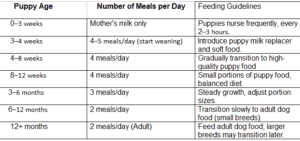Guide Natural Dog Food, Daily Grooming Routine, Best Dog Supplements, and Top Dog Care Products”

Understanding Dogs:
The dog was the first species to be domesticated by humans, over 14,000 years ago and before the development of agriculture. Due to their long association with humans, Complete dog care guide have gained the ability to thrive on a starch-rich diet that would be inadequate for other canids.
Dogs have been bred for desired behaviors, sensory capabilities, and physical attributes. Dog breeds vary widely in shape, size, and color. They have the same number of bones (except the tail), powerful jaws that house around 42 teeth, and well-developed senses of smell, hearing, and sight.
Communication in dogs includes eye gaze, facial expression, vocalization, body posture (including movements of bodies and limbs), and gustatory communication (scents, pheromones, and taste). They mark their territories by urinating on them, which is more likely when entering a new environment.
Why Dog Care Is More Than Just Feeding:
The diet of a dog must suit its individual needs. Breed, age, activity level, pregnancy, and health all affect nutrition. Dog owners should understand these needs to choose the right food—wet, dry, or homemade. With countless products and opinions, feeding a dog properly can be confusing, especially for new owners who need guidance on what, when, and how to feed.
No matter what you feed your dog, the food needs to be balanced and complete. Therefore, it needs to contain all the necessary nutrients for the individual dog. There are multiple options you could offer your dog, for example, dry or wet food, a vegetarian or vegan diet, or the BARF diet. Your pet must receive the correct mixing ratio of proteins, fats, carbohydrates, minerals, and vitamins with their food, and advice should be sought from a vet if you are unsure of the most suitable diet for your pet.
Puppies need high-quality puppy food suited to their development. For up to three months, divide meals into four portions daily. Gradually reduce meal frequency and transition to adult food with vet guidance. Adult dogs can be fed twice daily, with no more than 12 hours between meals. Smaller breeds may still benefit from multiple meals, even as adults.
A dog’s nutritional needs depend on its life stage, breed, neuter status, and activity level. Active dogs need more nutrients than less active ones. Use online calculators or consult a nutrition expert. Start with food manufacturer guidelines, monitor weight and body condition, and adjust portions as needed. Don’t forget to include treats in your dog’s total daily calorie intake.
Nutrition Guidelines to Create Balanced Homemade Dog Food Serving sizes usually vary according to your pet’s size, weight, and activity level.
Some nutrition guidelines you may like to keep in mind:
• 10% carbohydrates—beans and grains
• 40% protein—seafood, animal meat, dairy, eggs
• 50% fresh vegetables
• Fat from meat or oil
• Calcium—powdered or crushed eggshells, supplements
• Fatty acids—oatmeal, cooked egg yolks, plant oils

Emphasize holistic care: hygiene, mental health.
1. Clean Your Dog’s Litter Box Every Single Day
Cleaning your dog’s litter box daily prevents harmful bacteria buildup and bad odors and keeps your pet healthy. A clean environment reduces the risk of infections and encourages your dog to use the box consistently. Use mild, pet-safe cleaners, remove waste promptly, and wash the box regularly. Daily cleaning also helps you spot early signs of health issues like diarrhea or blood.
2. Wash Your Hands After Contact:
Go ahead and shower your pets with love, but always wash your hands after playing with, feeding, or cleaning up after them. This helps prevent disease spread through ingestion. The CDC recommends handwashing with soap and water to reduce the risk of zoonotic illnesses like E. coli, salmonella, and ringworm. Keep soap accessible throughout your home as a reminder.
3. Store Pet Food Properly:
Just like you wouldn’t eat food left out overnight, your pet shouldn’t either. Dry and wet dog food can grow harmful bacteria like salmonella if not stored properly. Use airtight containers and refrigerate wet food after opening. Avoid feeding raw food unless you’re careful—it carries a higher contamination risk. Never store open pet food outside or in garages, as it attracts rodents.
4. Clean Food and Water Dishes:
Pet bowls are among the germiest household items. Bacteria from saliva can linger and make pets or kids sick. Experts recommend washing food bowls daily and every one to two days for water bowls. Self-watering bowls need extra care due to mold buildup. Wash dishes by hand or in the dishwasher, especially if food residue remains.
5. Be Diligent About Flea and Tick Prevention:
Flea prevention protects pets and people from diseases like bubonic plague and Bartonellosis (cat-scratch fever), caused by Bartonella henselae. Regular flea treatments reduce transmission risk. Infected bites or scratches may lead to redness, fever, or fatigue. Wash your dog’s paws after walks with mild soap or baby wipes to prevent tracking bacteria, allergens, and parasites into your home.
6. Vacuum pet hair from furniture and floor:
Regular vacuuming is essential, especially for pet owners with allergies or asthma. Pets, especially cats, produce allergens like Fel d 1. Allergens affect both humans and pets—dust mites and mold can trigger reactions. Vacuum weekly with a HEPA filter, treat stains with enzymatic cleaners, and steam clean carpets every 6–12 months to reduce allergens and bacteria.
7. Wash and Replace Pet Toy:
Pet toys can harbor bacteria, yeast, and mold, causing skin infections with constant contact. Clean hard toys using hot soapy water and a mild bleach solution. Wash soft toys and collars in the machine—collars every 4–6 weeks. Replace worn toys to prevent ingestion risks, like polyester stuffing from damaged ones, say Dr. Zenithson Ng and Meier.
8. Clean your outdoor space:
Pick up dog waste promptly, especially where children play, says Stelow. Kids may accidentally ingest fecal bacteria like E. coli or salmonella. Immunocompromised individuals are also at risk. Diseases such as giardia, roundworm, and toxoplasmosis can spread. Always wear gloves and use waste bags or tools to remove feces safely, advises Canada’s Public Health Leader.
9. Use the Right Type of Cleaner:
Pick up dog waste promptly, especially where children play, says Stelow. Kids may accidentally ingest fecal bacteria like E. coli or salmonella. Immunocompromised individuals are also at risk. Diseases such as giardia, roundworm, and toxoplasmosis can spread. Always wear gloves and use waste bags or tools to remove feces safely, advises Canada’s Public Health Leader.
Choosing the Right Natural Dog Food:

The Benefits of Switching to Natural Dog Food
As awareness of pet nutrition grows, many owners are turning to natural dog food. This switch offers several key benefits. Let’s explore how this change can positively impact your dog’s health.
1. Optimal Nutrition for Vitality
Natural dog food uses real ingredients like quality proteins, grains, and nutrients. Unlike conventional food with fillers and additives, it supports strong immunity and overall health.
2. Improved Digestive Health
Free from artificial preservatives, natural food is easier to digest. Many options include probiotics and prebiotics to support gut health and reduce sensitivities.
3. Enhanced Skin and Coat Health
Natural food is rich in omega-3 and omega-6 fatty acids, which reduce inflammation and promote shiny coats and healthy skin—without artificial dyes or flavors.
4. Increased Energy and Vitality
With balanced nutrients and no fillers, natural dog food improves energy levels and supports active lifestyles through better nutrient absorption.
5. Weight Management and Healthy Aging
Natural diets promote lean muscle and reduce unhealthy weight gain. They’re ideal for supporting mobility and graceful aging in dogs of all breeds.
6. Allergy Management and Sensitivity Relief
Many natural formulas avoid common allergens, offering relief from food sensitivities and promoting comfort for dogs with special dietary needs.
How to transition your dog to a new diet:
Here’s our 7- to 10-day plan for switching dog care food:
⦁ Days 1 to 2: Feed 3/4 of the normal amount of current food and add 1/4 of the new food.
⦁ Days 3 to 4: Serve half the current food and half the new food.
⦁ Days 5 to 7: Feed 3/4 of the new food and 1/4 of the previous food.
⦁ Days 8 to 10: Serve only the new food.
10 Best Ingredients in Dog Food in India:
Daily Grooming Routine for Dogs
Dogs Grooming Tips:
⦁ Brush their coats to keep their fur and skin healthy and clean.
⦁ Brush their teeth at least once a day.
⦁ Trim their nails.
⦁ Clean their ears to prevent infection.
⦁ Wash their face to eliminate bacteria.
⦁ Clean around their eyes to remove eye goop.
⦁ Give them a bath to keep them smelling great.
Essential Dog Care Products Every Owner Should Have:
The Best Dog Supplements for Health and Longevity:
Top 5 Common deficiencies in dogs:
1. Vitamins:
Vitamins are organic molecules that an organism needs in relatively small amounts to support proper metabolic function. The body does not synthesize essential nutrients in enough quantity for an organism to survive on its own, and therefore it must get them from food.
2. Obesity:
Obesity increases the risk of arthritis, diabetes, and cancer and shortens your dog’s lifespan. It results from consuming more calories than burned, often due to overeating and lack of exercise. Watch portion sizes, limit treats, and ensure your dog gets regular physical activity—especially if their breed is prone to weight gain.
3. Pancreatitis:
Pancreatitis is inflammation of the pancreas, often triggered by high-fat foods, food allergies, or sensitivities. After an episode, most dogs require a low-fat diet, sometimes for life. A lean, fit dog is less at risk. Avoid feeding fatty leftovers and keep garbage securely out of reach to help prevent this painful condition.
4. Bone Disease in Dogs:
Nutritional imbalances are a leading cause of bone disorders in young dogs, often due to deficiencies in calcium, phosphorus, or vitamin D—key nutrients for healthy bone development. Ironically, over-supplementation can also lead to bone problems. Dogs require balanced nutrition, not excessive vitamins or minerals “just in case.” Always consult a canine nutritionist before adding supplements to your dog’s diet to ensure optimal bone health.
5. Colitis in Dogs:
Colitis is inflammation of the colon, often caused by diet, stress, infections, or parasites, making it hard to diagnose. While chronic colitis can’t be cured, it can be managed with medication, veterinary dog care, and a strict diet. Using a novel protein, adjusting fat and fiber intake, and monitoring your dog’s response are essential for control.
10 Best Food Supplements for Dogs in India:
⦁ Henlo Everyday Nutrition Topper supplement and multivitamin.
⦁ PET360 Omega 3+6 Concentrated salmon Fish Oil for Dogs & Cats with Vitamin & Minerals
⦁ PET 360 Digest+ Tummy Care Formula | Guts Health Supplements for Dogs & Cats.
⦁ PETZ Home Food Plus, Vegetarian Dog Feed Supplement
⦁ Petroyale Digestive Probiotics for Dogs—Prebiotics & Probiotics Supplement Powder
⦁ PET360 Omega 3+6 Concentrated Salmon Fish Oil for Dogs & Cats with Vitamin & Minerals
⦁ Beaphar Bone Builder Powder with Calcium
⦁ PET360 Probiotics + prebiotics gut wellness formula for Dogs & Cats
⦁ FURVITAL MULTI-VITAMIN CHEWS
⦁ Drools Optimum Performance Adult Dry Dog Food, Chicken, 10kg & Absolute Calcium Tablet—Dog Supplement, 50 Pieces.
Common Dog Health Problems and Prevention Tips:
1. Skin Problems
Skin problems are one of the most common complaints from dogs. You may observe your dog scratching more than usual, or seeing red inflamed areas on his skin. Allergic reactions, fleas, ticks, and infections also can aggravate skin issues. Grooming and flea control will help prevent skin issues. A well-balanced diet (with omega-3 fatty acids) will also help maintain healthy skin and coat.
2. Ear Infections
Ear infections in dogs that have floppy ears and who also like to swim can be very common. Symptoms of an ear infection include scratching at the ears, shaking of the head, and a bad smell. To prevent an ear infection in your dog, keep his ears clean and dry, inspect them regularly for excess wax and debris, and see your veterinarian if any signs of infection occur.
3. Dental Disease
Dental problems are not just a human thing. More than 80% of dogs by the age of three have problems with their teeth. This can lead to pain and bad breath, as well as organ damage if left untreated. Brushing and feeding your dog oral care treats can help keep their teeth and gums healthy. Don’t forget those yearly checkups with your vet.
4. Parasites
Parasites such as fleas, ticks, and worms can do terrible damage to your dog’s health. They can cause mild irritation to serious diseases but are very preventable. Regular use of preventative medications, keeping your dog’s environment clean, and checking for ticks after outdoor activity reduce the likelihood of your pet becoming infested.
5. Joint Problems
As your dog ages, they may develop joint problems such as arthritis. This can lead to pain and decreased mobility. To help prevent joint problems, you should keep your dog care at a healthy weight and do a lot of exercises that are specifically rated for them. Supplements such as glucosamine and chondroitin can also help with joint health.
Conclusion:
Caring for a dog goes far beyond feeding and shelter—it’s about committing to their overall well-being every single day. From providing balanced natural nutrition to following a consistent grooming routine, monitoring for health issues, and using the right supplements and care products, every step contributes to a healthier, longer, and happier life for your pet. By understanding your dog’s individual needs—whether it’s related to diet, exercise, hygiene, or seasonal care—you can offer personalized support that keeps them thriving.
Whether you’re a first-time dog owner or a seasoned pet parent, staying informed and proactive is key. Regular vet checkups, proper hygiene, and thoughtful nutrition choices ensure your dog not only lives—but lives well. With love, attention, and a little expert guidance, your dog care becomes more than just a pet—they become family.

